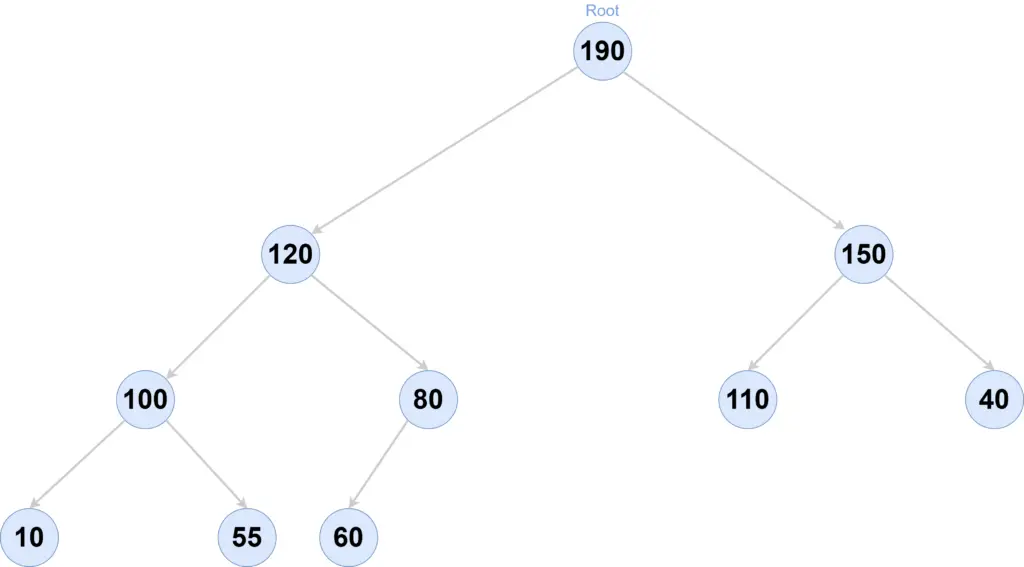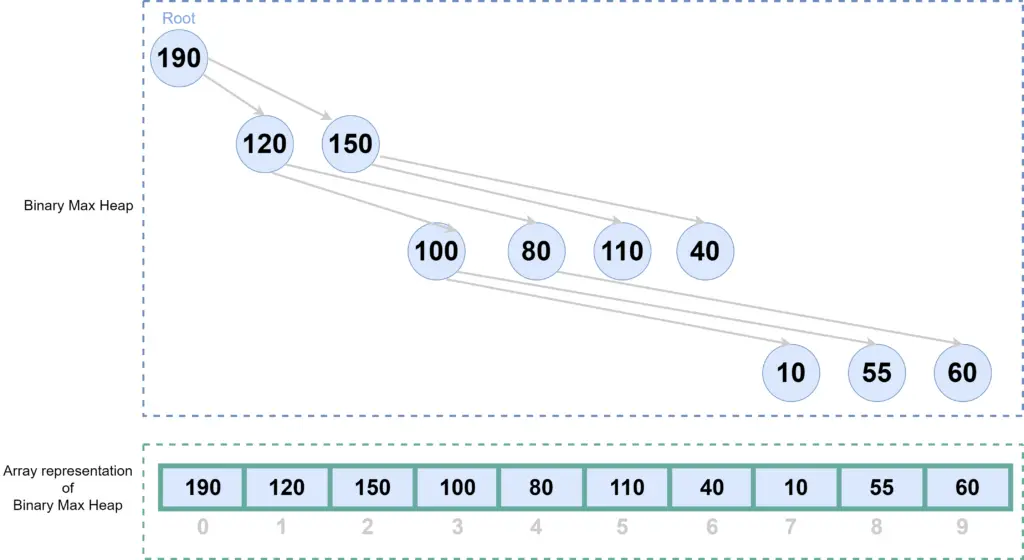Priority queues are very frequently used data structures. Used to generate a queue so that we can process the items based on the priority of it.
![]() NOTE
NOTE
In this article, we are discussing the implementation of Priority Queue in JavaScript and TypeScript.
Here we are using a Max Binary Heap to implement the Priority Queue. The code is mostly the same as Max Binary Heap, there are just a few differences-
Priority Queue using Max Binary Heap

If we represent this Heap(binary tree) in an array, it will look like below-

Notice the indexes of the elements. Here can find the index of child elements from the index of parent, can find parent from the index of children, using the following formula-
- If the parent element is in N th index, then-
- Left child index: 2N + 1
- Right child index: 2N + 2
- If the child element is in N th index, then-
- Parent element index: floor((N – 1) / 2)
Step #1: Node Class
class Node {
constructor(data, priority) {
this.data = data;
this.priority = priority;
}
}class Node {
constructor(data, priority) {
this.data = data;
this.priority = priority;
}
}Step #2: Priority Queue Class
class PriorityQueue {
constructor() {
this.nodes = [];
}
}Step #3: Enqueue Method
class PriorityQueue {
constructor() {
this.nodes = [];
}
// Insert item to the Heap
enqueue(data, priority) {
const newNode = new Node(data, priority);
// assume the item will be inserted
// at the end of the array initially
let itemIndex = this.nodes.length;
while (itemIndex > 0) {
// Get the index of parent of the new data
// Calculate by index
// If index of an element is N, the then parent index is Floor((N - 1) / 2)
const parentIndex = Math.floor((itemIndex - 1) / 2);
// if current item is smaller than then parent then we are good
// No changes required in that case
if (parentIndex < 0 || this.nodes[parentIndex].priority > newNode.priority) {
break;
}
this.nodes[itemIndex] = this.nodes[parentIndex];
itemIndex = parentIndex;
}
// finally push the item in the selected index
this.nodes[itemIndex] = newNode;
return itemIndex;
}
}
export default PriorityQueue;
Step #4: Queue Position Setting Utility Method
Define method “setQueuePosition”. This method is used to move an item to the correct position based on the priority.
This function recursively calls itself until all the nodes reach the correct position.
class PriorityQueue {
constructor() {
this.nodes = [];
}
// --- other functions ---
// Utility function to bring an element
// to it's correct postion
setQueuePosition(currentIndex) {
let largestIndex = currentIndex;
let leftIndex = currentIndex * 2 + 1;
let rightIndex = currentIndex * 2 + 2;
if (
leftIndex < this.nodes.length &&
this.nodes[leftIndex].priority > this.nodes[largestIndex].priority
) {
largestIndex = leftIndex;
}
if (
rightIndex < this.nodes.length &&
this.nodes[rightIndex].priority > this.nodes[largestIndex].priority
) {
largestIndex = rightIndex;
}
// If either left or right node is larger than current node then swap
if (largestIndex !== currentIndex) {
const temp = this.nodes[currentIndex];
this.nodes[currentIndex] = this.nodes[largestIndex];
this.nodes[largestIndex] = temp;
// setQueuePosition the largest index element again
this.setQueuePosition(largestIndex);
}
}
}Step #5: Dequeue Method
class PriorityQueue {
constructor() {
this.nodes = [];
}
// --- other functions ---
// Extract the max item from the Heap
dequeue() {
// The max item is at the root
// So extract and store that in a const
const maxItem = this.nodes[0];
// Get the last element
const lastItem = this.nodes.pop();
// Implement setQueuePosition if there are items left
if (this.nodes.length > 0) {
// Set the last item as the root (temporary)
// The position is most probably not correct for this node
// we are setting this for now
// we will take it to the correct position in the next step
this.nodes[0] = lastItem;
// Bring the root element down if it is not the max item
this.setQueuePosition(0);
}
// Return the extracted node
return maxItem;
}
}Full Source Code
Here is the full source code of the Priority Queue implementation-
// pq.js
// Priority Queue implementation in JavaScript
class Node {
constructor(data, priority) {
this.data = data;
this.priority = priority;
}
}
class PriorityQueue {
constructor() {
this.nodes = [];
}
// Insert item to the Heap
enqueue(data, priority) {
const newNode = new Node(data, priority);
// assume the item will be inserted
// at the end of the array initially
let itemIndex = this.nodes.length;
while (itemIndex > 0) {
// Get the index of parent of the new data
// Calculate by index
// If index of an element is N, the then parent index is Floor((N - 1) / 2)
const parentIndex = Math.floor((itemIndex - 1) / 2);
// if current item is smaller than then parent then we are good
// No changes required in that case
if (parentIndex < 0 || this.nodes[parentIndex].priority > newNode.priority) {
break;
}
this.nodes[itemIndex] = this.nodes[parentIndex];
itemIndex = parentIndex;
}
// finally push the item in the selected index
this.nodes[itemIndex] = newNode;
return itemIndex;
}
// Extract the max item from the Heap
dequeue() {
// The max item is at the root
// So extract and store that in a const
const maxItem = this.nodes[0];
// Get the last element
const lastItem = this.nodes.pop();
// Implement setQueuePosition if there are items left
if (this.nodes.length > 0) {
// Set the last item as the root (temporary)
// The position is most probably not correct for this node
// we are setting this for now
// we will take it to the correct position in the next step
this.nodes[0] = lastItem;
// Bring the root element down if it is not the max item
this.setQueuePosition(0);
}
// Return the extracted node
return maxItem;
}
// Utility function to bring an element
// to it's correct postion
setQueuePosition(currentIndex) {
let largestIndex = currentIndex;
let leftIndex = currentIndex * 2 + 1;
let rightIndex = currentIndex * 2 + 2;
if (
leftIndex < this.nodes.length &&
this.nodes[leftIndex].priority > this.nodes[largestIndex].priority
) {
largestIndex = leftIndex;
}
if (
rightIndex < this.nodes.length &&
this.nodes[rightIndex].priority > this.nodes[largestIndex].priority
) {
largestIndex = rightIndex;
}
// If either left or right node is larger than current node then swap
if (largestIndex !== currentIndex) {
const temp = this.nodes[currentIndex];
this.nodes[currentIndex] = this.nodes[largestIndex];
this.nodes[largestIndex] = temp;
// setQueuePosition the largest index element again
this.setQueuePosition(largestIndex);
}
}
}
export default PriorityQueue;
Demo
Use the following code to check the implementation-
// demo.js
import PriorityQueue from "./pq.js";
// Create a new Priority Queue
let bigBoxPriorityQueue = new PriorityQueue();
console.log("\n----------- Priority Queue - Enqueue example -----------\n");
// Enqueue items
console.log("Enqueue - 100| Result Index: ", bigBoxPriorityQueue.enqueue('Shad Skiles', 100));
console.log("Enqueue - 150| Result Index: ", bigBoxPriorityQueue.enqueue('Isaias Hackett', 150));
console.log("Enqueue - 80| Result Index: ", bigBoxPriorityQueue.enqueue('Reggie Blick', 80));
console.log("Enqueue - 110| Result Index: ", bigBoxPriorityQueue.enqueue('Kali Feil', 110));
console.log("Enqueue - 40| Result Index: ", bigBoxPriorityQueue.enqueue('Jadyn Lesch', 40));
console.log("Enqueue - 120| Result Index: ", bigBoxPriorityQueue.enqueue('Candice Braun', 120));
console.log("Enqueue - 10| Result Index: ", bigBoxPriorityQueue.enqueue('Bailey Keeling', 10));
console.log("Enqueue - 190| Result Index: ", bigBoxPriorityQueue.enqueue('Jamil Bartoletti', 190));
console.log("Enqueue - 55| Result Index: ", bigBoxPriorityQueue.enqueue('Laurie Rowe', 55));
console.log("Enqueue - 60| Result Index: ", bigBoxPriorityQueue.enqueue('Jed Emard', 60));
console.log(
"\n\n----------- Priority Queue - Dequeue example -----------\n"
);
for (let i = 0; i < 12; i++) {
console.log("Dequeue | Result: ", bigBoxPriorityQueue.dequeue());
}
Output:
Here is the output of the demo code-
----------- Priority Queue - Enqueue example -----------
Enqueue - 100| Result Index: 0
Enqueue - 150| Result Index: 0
Enqueue - 80| Result Index: 2
Enqueue - 110| Result Index: 1
Enqueue - 40| Result Index: 4
Enqueue - 120| Result Index: 2
Enqueue - 10| Result Index: 6
Enqueue - 190| Result Index: 0
Enqueue - 55| Result Index: 8
Enqueue - 60| Result Index: 4
----------- Priority Queue - Dequeue example -----------
Dequeue | Result: Node { data: 'Jamil Bartoletti', priority: 190 }
Dequeue | Result: Node { data: 'Isaias Hackett', priority: 150 }
Dequeue | Result: Node { data: 'Candice Braun', priority: 120 }
Dequeue | Result: Node { data: 'Kali Feil', priority: 110 }
Dequeue | Result: Node { data: 'Shad Skiles', priority: 100 }
Dequeue | Result: Node { data: 'Reggie Blick', priority: 80 }
Dequeue | Result: Node { data: 'Jed Emard', priority: 60 }
Dequeue | Result: Node { data: 'Laurie Rowe', priority: 55 }
Dequeue | Result: Node { data: 'Jadyn Lesch', priority: 40 }
Dequeue | Result: Node { data: 'Bailey Keeling', priority: 10 }
Dequeue | Result: undefined
Dequeue | Result: undefinedTesting
Here are the tests for the Priority Queue implementation-
// pq.test.js
import { describe, it, beforeEach, expect } from "vitest";
import PriorityQueue from "./pq";
describe("Priority Queue", () => {
let priorityQueue;
beforeEach(() => {
priorityQueue = new PriorityQueue();
priorityQueue.enqueue("Shad Skiles", 100);
priorityQueue.enqueue("Isaias Hackett", 150);
priorityQueue.enqueue("Reggie Blick", 80);
priorityQueue.enqueue("Kali Feil", 110);
priorityQueue.enqueue("Jadyn Lesch", 40);
priorityQueue.enqueue("Candice Braun", 120);
priorityQueue.enqueue("Bailey Keeling", 10);
priorityQueue.enqueue("Jamil Bartoletti", 190);
priorityQueue.enqueue("Laurie Rowe", 55);
priorityQueue.enqueue("Jed Emard", 60);
});
describe("Enqueue item to Priority Queue", () => {
it("Should have correct length", () => {
expect(priorityQueue.nodes.length).toBe(10);
});
it("Should have correct sequence of items", () => {
expect(priorityQueue.nodes.map(node => node.priority)).toMatchObject([
190, 150, 120, 110, 60, 80, 10, 100, 55, 40,
]);
});
});
describe("Dequeue items from Priority Queue", () => {
it("Should dequeue correct item", () => {
expect(priorityQueue.dequeue().priority).toBe(190);
expect(priorityQueue.dequeue().priority).toBe(150);
expect(priorityQueue.dequeue().priority).toBe(120);
expect(priorityQueue.dequeue().priority).toBe(110);
expect(priorityQueue.dequeue().priority).toBe(100);
expect(priorityQueue.dequeue().priority).toBe(80);
expect(priorityQueue.dequeue().priority).toBe(60);
expect(priorityQueue.dequeue().priority).toBe(55);
expect(priorityQueue.dequeue().priority).toBe(40);
expect(priorityQueue.dequeue().priority).toBe(10);
expect(priorityQueue.dequeue()).toBeUndefined();
});
});
});
Time Complexity
| Operation | Complexity |
|---|---|
| Insert | O(log N) |
| Extract Max | O(log N) |
Source Code
Use the following links to get the source code used in this article-
| Source Code of | Implementation Code | Demo Code | Test Code |
|---|---|---|---|
| JavaScript Implementation | |||
| TypeScript Implementation |
Related Data Structures
| Command | Details |
|---|---|
| Binary Heap |
Other Code Implementations
Use the following links to check the BFS implementation in other programming languages-



